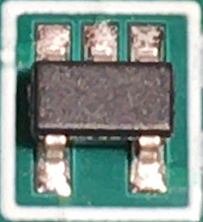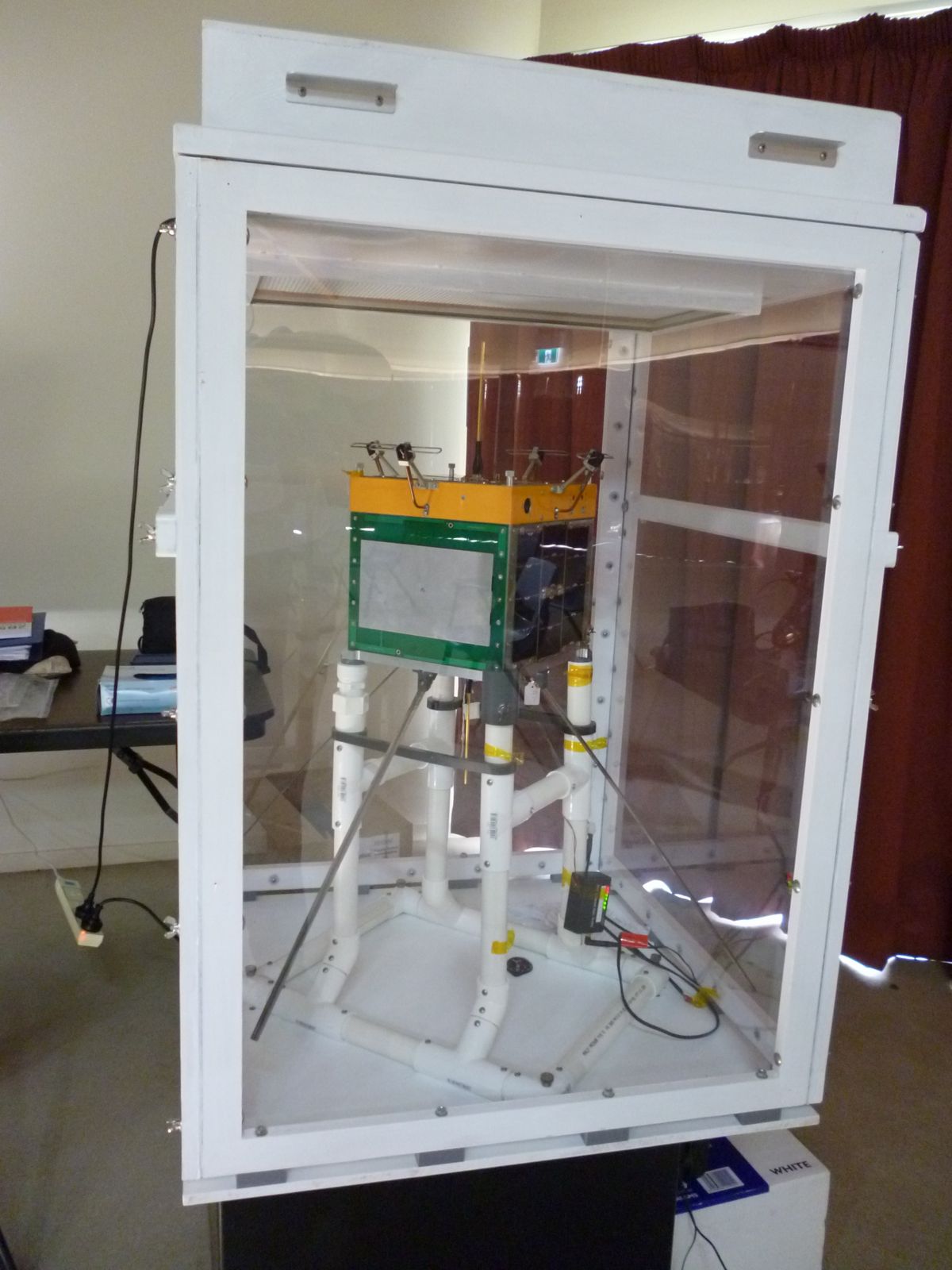|
UoSAT-2
UoSAT-2, which is also known as UO-11 and OSCAR-11, is a British satellite orbiting in Low Earth Orbit. The satellite functions as an amateur radio transmitter (known as an OSCAR) and was built at the University of Surrey. It launched into orbit in March 1984 and remains orbital and active, though unstable with irregular periods of transmission. All of the analogue telemetry channels failed in 2005, but as of 2014 the status channels were still operational. The satellite was still heard transmitting telemetry in 2025, forty-one years after launch. It was operated by Surrey Satellite Technology Ltd. Characteristics The satellite was the second in the UoSAT series of satellites built by University of Surrey; preceded by UoSAT-1 and followed by UoSAT-3. The satellite carries a Digitalker speech synthesiser, magnetometers, a CCD camera, a Geiger-Müller tube, and a microphone to detect the vibrations of micrometeoroid impacts. Like UoSAT-1 it transmits telemetry data on the ... [...More Info...] [...Related Items...] OR: [Wikipedia] [Google] [Baidu] |
UoSat-OSCAR 9
UoSAT-1, also known as UoSAT-OSCAR 9 (UO-9), was a British amateur radio satellite which orbited Earth. It was built at the University of Surrey and launched into low Earth orbit on 6 October 1981. It exceeded its anticipated two-year orbital lifespan by six years, having received signals on 13 October 1989, before re-entering the atmosphere. This was the first of several UoSAT satellites; followed by UoSAT-2. Mission Like its successor UoSAT-2 it carried a CCD camera and a Digitalker speech synthesiser, and transmitted telemetry data on a 145.826 MHz beacon at 1200 baud using asynchronous AFSK. The ''Astrid'' package sold by British firm MM Microwave, consisting of a fixed frequency VHF receiver set and software for the BBC Micro, could display the telemetry frames from either UoSAT-1 or UoSAT-2. UoSAT-1's solar arrays were of an experimental design reused for UoSAT-2. Computers and Data Processing The primary computer for the satellite was the RCA 1802 The COSMAC ... [...More Info...] [...Related Items...] OR: [Wikipedia] [Google] [Baidu] |
Surrey Satellite Technology Ltd
Surrey Satellite Technology Ltd, or SSTL, is a company involved in the manufacture and operation of small satellites. A spin-off company of the University of Surrey, it is presently wholly owned by Airbus Defence and Space. The company began out of research efforts centred upon amateur radio satellites, known by the UoSAT (University of Surrey Satellite) name or by an OSCAR (Orbital Satellite Carrying Amateur Radio) designation. SSTL was founded in 1985, following successful trials on the use of commercial off-the-shelf (COTS) components on satellites, cumulating in the ''UoSat-1'' test satellite. It funds research projects with the university's Surrey Space Centre, which does research into satellite and space topics. In April 2008, the University of Surrey agreed to sell its majority share in the company to European multinational conglomerate EADS Astrium. In August 2008, SSTL opened a US subsidiary, which included both offices and a production site in Denver, Colorado; [...More Info...] [...Related Items...] OR: [Wikipedia] [Google] [Baidu] |
University Of Surrey
The University of Surrey is a public research university in Guildford, Surrey, England. The university received its Royal Charter, royal charter in 1966, along with a Plate glass university, number of other institutions following recommendations in the Robbins Report. The institution was previously known as Battersea College of Technology and was located in Battersea Park, London. Its roots however, go back to Battersea Polytechnic Institute, founded in 1891 to provide Vocational education, further and higher education in London, including its poorer inhabitants. The university is a member of the Association of MBAs and is one of four universities in the University Global Partnership Network. It is also part of the SETsquared partnership along with the University of Bath, the University of Bristol, the University of Southampton, and the University of Exeter. The university's main campus is on Stag Hill, University of Surrey, Stag Hill, close to the centre of Guildford and adjacen ... [...More Info...] [...Related Items...] OR: [Wikipedia] [Google] [Baidu] |
Eclipse
An eclipse is an astronomical event which occurs when an astronomical object or spacecraft is temporarily obscured, by passing into the shadow of another body or by having another body pass between it and the viewer. This alignment of three celestial objects is known as a ''syzygy''. An eclipse is the result of either an '' occultation'' (completely hidden) or a ''transit'' (partially hidden). A "deep eclipse" (or "deep occultation") is when a small astronomical object is behind a bigger one. "What is a deep eclipse? The smaller star is behind the bigger star" The term ''eclipse'' is most often used to describe either a solar eclipse, when the Moon's shadow crosses the Earth's surface, or a lunar eclipse, when the Moon moves into the Earth's shadow. However, it can also refer to such events beyond the Earth–Moon system: for example, a planet moving into the shadow cast by one of its moons, a moon passing into the shadow cast by its host planet, or a moon passing into the ... [...More Info...] [...Related Items...] OR: [Wikipedia] [Google] [Baidu] |
Watchdog Timer
A watchdog timer (WDT, or simply a ''watchdog''), sometimes called a ''computer operating properly timer'' (''COP timer''), is an electronic or software timer that is used to detect and recover from computer malfunctions. Watchdog timers are widely used in computers to facilitate automatic correction of temporary hardware faults, and to prevent errant or malevolent software from disrupting system operation. During normal operation, the computer regularly restarts the watchdog timer to prevent it from elapsing, or ''timeout (computing), timing out''. If, due to a hardware fault or program error, the computer fails to restart the watchdog, the timer will elapse and generate a timeout signal. The timeout signal is used to initiate corrective actions. The corrective actions typically include placing the computer and associated hardware in a safe state and invoking a computer reboot. Microcontrollers often include an integrated, on-chip watchdog. In other computers the watchdog may re ... [...More Info...] [...Related Items...] OR: [Wikipedia] [Google] [Baidu] |
Photovoltaic Module
Photovoltaics (PV) is the conversion of light into electricity using semiconducting materials that exhibit the photovoltaic effect, a phenomenon studied in physics, photochemistry, and electrochemistry. The photovoltaic effect is commercially used for electricity generation and as photosensors. A photovoltaic system employs solar modules, each comprising a number of solar cells, which generate electrical power. PV installations may be ground-mounted, rooftop-mounted, wall-mounted or floating. The mount may be fixed or use a solar tracker to follow the sun across the sky. Photovoltaic technology helps to mitigate climate change because it emits much less carbon dioxide than fossil fuels. Solar PV has specific advantages as an energy source: once installed, its operation does not generate any pollution or any greenhouse gas emissions; it shows scalability in respect of power needs and silicon has large availability in the Earth's crust, although other materials required ... [...More Info...] [...Related Items...] OR: [Wikipedia] [Google] [Baidu] |
Serial Port
A serial port is a serial communication Interface (computing), interface through which information transfers in or out sequentially one bit at a time. This is in contrast to a parallel port, which communicates multiple bits simultaneously in Parallel communication, parallel. Throughout most of the history of personal computers, data has been transferred through serial ports to devices such as modems, computer terminal, terminals, various peripherals, and directly between computers. While interfaces such as Ethernet, FireWire, and USB also send data as a serial Stream (computing), stream, the term ''serial port'' usually denotes Computer hardware, hardware compliant with RS-232 or a related standard, such as RS-485 or RS-422. Modern consumer personal computers (PCs) have largely replaced serial ports with higher-speed standards, primarily USB. However, serial ports are still frequently used in applications demanding simple, low-speed interfaces, such as industrial automation sys ... [...More Info...] [...Related Items...] OR: [Wikipedia] [Google] [Baidu] |
AMSAT
AMSAT is a name for various amateur radio satellite organizations worldwide. In particular, it often refers to the Radio Amateur Satellite Corporation, headquartered in Washington, D.C. AMSAT organizations design, build, arrange launches for, and then operate (command) satellites carrying amateur radio payloads, including the OSCAR series of satellites. Other informally affiliated national organizations exist, such as AMSAT Germany (AMSAT-DL) and AMSAT Japan (JAMSAT). History AMSAT was founded in 1969 in Washington, D.C. to continue the efforts begun by OSCAR, Project OSCAR. Its first project was to coordinate the launch of Australis-OSCAR 5, OSCAR 5, constructed by students at the University of Melbourne. Some design modifications were needed and were made by AMSAT members, and the satellite was successfully launched on 30 January 1970, on a NASA Delta (rocket family), Thor Delta launch vehicle. AMSAT's next launch was AMSAT-OSCAR 6 (AO-6) on 15 October 1972. AO-6 was AMSAT' ... [...More Info...] [...Related Items...] OR: [Wikipedia] [Google] [Baidu] |
S Band
The S band is a designation by the Institute of Electrical and Electronics Engineers (IEEE) for a part of the microwave band of the electromagnetic spectrum covering frequencies from 2 to 4 gigahertz (GHz). Thus it crosses the conventional boundary between the UHF and SHF bands at 3.0 GHz. The S band is used by airport surveillance radar for air traffic control, weather radar, surface ship radar, and some communications satellites, particularly satellites used by NASA to communicate with the Space Shuttle and the International Space Station. The 10 cm radar short-band ranges roughly from 1.55 to 5.2 GHz. India's regional satellite navigation network ( IRNSS) broadcasts on 2.483778 to 2.500278 GHz. The S band also contains the 2.4–2.483 GHz ISM band, widely used for low power unlicensed microwave devices such as cordless phones, wireless headphones (Bluetooth), garage door openers, keyless vehicle locks, baby monitors as well as for medical ... [...More Info...] [...Related Items...] OR: [Wikipedia] [Google] [Baidu] |
The Micro User
''The Micro User'' (titled ''BBC Micro User'' in the first three issues) was a British specialist magazine catering to users of the BBC Microcomputer series, Acorn Electron, Acorn Archimedes and, to a limited extent, the Cambridge Z88. It had a comprehensive mix of reviews of games, application software, and the latest Acorn computers; type-in programs (duplicated on a " cover disk" which was available separately), a correspondence page offering help with computer problems, and approachable technical articles on programming and the BBC Micro's internals. The magazine hosted the long-running ''Body Building'' series by Mike Cook, in which each article introduced a small electronics project that could be built and connected to one of the BBC Micro's I/O ports. The project could be ordered in kit form or fully assembled, or the reader could source the parts and design as the articles contained a circuit diagram. There were regular columns on adventure gaming from two successive ... [...More Info...] [...Related Items...] OR: [Wikipedia] [Google] [Baidu] |






